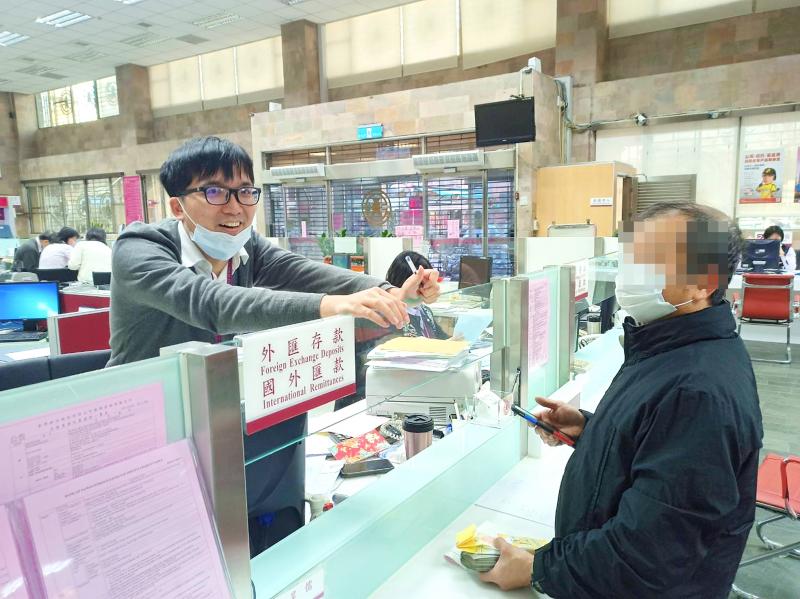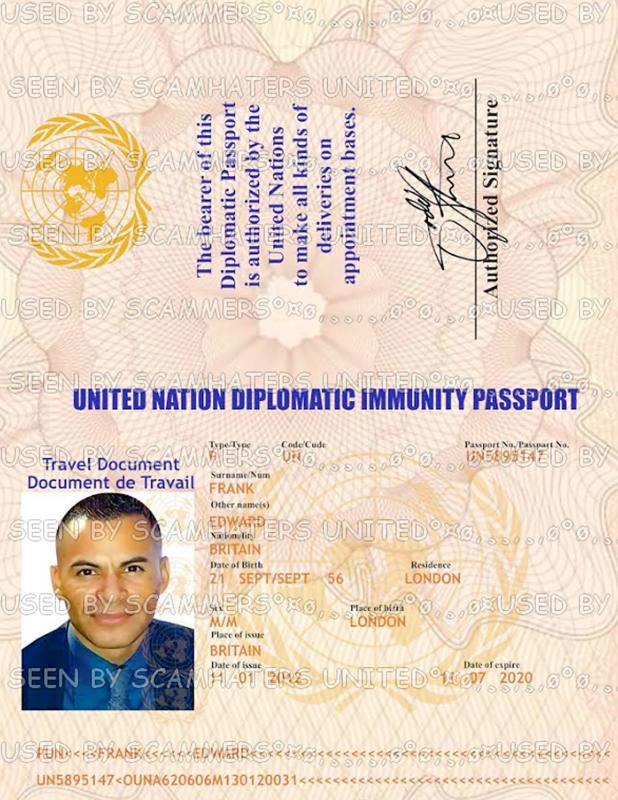When a 59-year-old deaf-mute man surnamed Hsu had an online encounter with a foreigner who claimed to be a diplomat, he nearly ended up as the victim of a fraud syndicate.
A police investigation revealed that Hsu had got to know a foreign Internet user calling himself “Alvin,” who said that he was a diplomat from a certain country but was not in a position to reveal his identity because he was on a secret mission abroad. He said he had a parcel that he urgently needed to send back to Taiwan, and he hoped Hsu could take delivery of it. Next, someone claiming to represent a courier company sent Hsu a message saying that he would need to pay tax and customs fees to collect the parcel, and asking Hsu to go to a bank to transfer the money.
Without thinking, on Jan. 11 Hsu did as he had been asked by going to Chang Hwa Bank’s Shuangyuan branch in Taipei, where he applied to transfer the sum of NT$30,000. However, the bank staff noticed that something was out of order and reported it to Wanhua Police Precinct’s Yingguang Police Station. Police officers Hsu Li-yuan and Tung Yu-hsuan hurried to the scene, where they determined that Hsu had encountered a fraud syndicate. Using written notes, the police officers told Hsu about some related cases, and only then did he give up the idea of transferring the money.

Photo copied by Wang Kuan-jen, Liberty Times 照片:自由時報王冠仁翻攝
However, the fraud syndicate was not ready to give up, and they used clever talk to persuade Hsu into making another trip to a bank on Jan. 19, this time to the Bank of Taiwan’s Longshan branch, where he applied to make a transfer of NT$84,000. Luckily, the bank staff again noticed that something was amiss and reported it to the police. On receiving the report, Deputy Chief Chen Chin-tien of Kangding Police Station went to the scene, where he used a pen and paper to explain that he was a police officer. He then read through the recorded conversations between Hsu and the other parties, from which he discovered that the fraud syndicate was once again using the same method to trick Hsu.
Wanhua Police Precinct urges the public to remember that if they receive phone calls from an unknown caller they should make detailed enquiries and immediately dial the 165 or 110 hotlines to check, so that they do not fall foul of scammers. The police said that everyone should keep in mind the triple formula of “Don’t rush; don’t be anxious; think carefully” and do a detailed check, because that is the only effective way to avoid becoming a target for scammers’ greed.
(Translated by Julian Clegg, Taipei Times)

Photo: Scamhaters United 照片:Scamhaters United
五十九歲徐姓瘖啞人士,透過網路認識一名聲稱是外交官的外籍網友,結果差一點成為詐騙集團的被害人。
警方調查,徐男透過網路認識一名自稱「阿爾文」的外籍網友,對方說他是某國外交官,因為在海外執行秘密任務、身分不便曝光。「阿爾文」又說他有一份包裹要緊急寄回台灣,希望徐能夠幫忙簽收。隨後又有自稱快遞公司人員傳訊息給徐,聲稱要領包裹必須支付稅金、海關費等,要徐前去銀行匯款。
徐一時不察,一月十一日依對方所說,前往台北市彰化銀行雙園分行要臨櫃匯款三萬元,但行員發現異狀,通報轄區萬華分局莒光所;警員許?元、董羽軒趕到現場,發現徐遇上詐騙集團,隨即用筆談方式告訴他相關案例,他才放棄匯款。

Photo: Military Romance Scams Facebook page 照片:Military Romance Scams臉書
不過,詐騙集團不死心,又用話術對徐「洗腦」,徐又於一月十九日台灣銀行龍山分行要臨櫃匯款八萬四千元;幸虧行員再次發現異狀,通報警方。康定路派出所副所長陳進添獲報前往,以紙筆書寫表示警察身分,且經查看徐與對方的對話紀錄,發現詐騙集團又用相同手法騙徐。
萬華分局呼籲,民眾如接獲不明電話應詳細查詢,請立即撥打165或110專線查證,以免落入詐騙陷阱,並切記三要訣「勿急、勿躁、多思考」!詳加查證,才能有效避免成為歹徒覬覦目標。
(自由時報)

In an effort to fight phone scams, British mobile phone company O2 has introduced Daisy, an AI designed to engage phone con artists in time-wasting conversations. Daisy is portrayed as a kindly British granny, exploiting scammers’ tendency to target the elderly. Her voice, based on a real grandmother’s for authenticity, adds to her credibility in the role. “O2” has distributed several dedicated phone numbers online to direct scammers to Daisy instead of actual customers. When Daisy receives a call, she translates the scammers’ spoken words into text and then responds to them accordingly through a text-to-speech system. Remarkably, Daisy

Bilingual Story is a fictionalized account. 雙語故事部分內容純屬虛構。 Emma had reviewed 41 resumes that morning. While the ATS screened out 288 unqualified, she screened for AI slop. She could spot it a mile away. She muttered AI buzzwords like curses under her breath. “Team player.” “Results-driven.” “Stakeholder alignment.” “Leveraging core competencies.” Each resume reeked of AI modeling: a cemetery of cliches, tombstones of personality. AI wasn’t just changing hiring. It was draining the humanity from it. Then she found it: a plain PDF cover letter. No template. No design flourishes. The first line read: “I once tried to automate my

Every May 1, Hawaii comes alive with Lei Day, a festival celebrating the rich culture and spirit of the islands. Initiated in 1927 by the poet Don Blanding, Lei Day began as a tribute to the Hawaiian custom of making and wearing leis. The idea was quickly adopted and officially recognized as a holiday in 1929, and leis have since become a symbol of local pride and cultural preservation. In Hawaiian culture, leis are more than decorative garlands made from flowers, shells or feathers. For Hawaiians, giving a lei is as natural as saying “aloha.” It shows love and

1. 他走出門,左右看一下,就過了馬路。 ˇ He walked outside, looked left and right, and crossed the road. χ He walked outside and looked left and right, crossed the road. 註︰並列連接詞 and 在這句中連接三個述語。一般的結構是 x, y, and z。x and y and z 是加強語氣的結構,x and y, z 則不可以。 2. 他們知道自己的弱點以及如何趕上其他競爭者。 ˇ They saw where their weak points lay and how they could catch up with the other competitors. χ They saw where their weak points lay and how to catch up with the other competitors. 註:and 一般連接同等成分,結構相等的單詞、片語或子句。誤句中 and 的前面是子句,後面是不定詞片語,不能用 and 連接,必須把不定詞片語改為子句,and 前後的結構才相等。 3. 她坐上計程車,直接到機場。 ˇ She took a cab, which took her straight to the airport. ˇ She took a cab and it took her straight